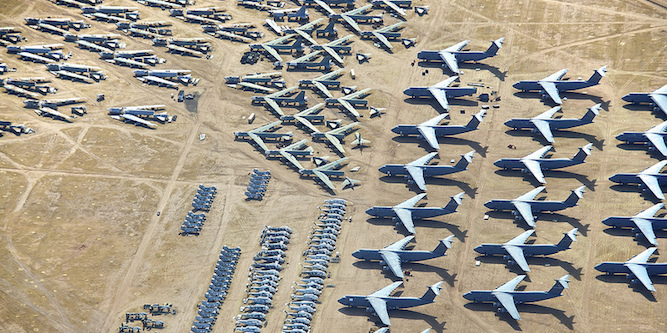
June 1, 2022
How Are Planes Decommissioned, and How Much Value Can Be Salvaged From Their Parts?
Tags:
(Photo Credit: Davis-Monthan Air Force Base, via Creative Commons)
The huge hunks of metal that soar across our skies don’t fly forever. There comes a time when every airplane has to be permanently grounded. How long do jets last? Where do they go after they’ve made their final landing? And how much do secondhand parts sell for?
After their retirement, planes end up in dusty parking lots known as “boneyards.” Get to know one of the largest boneyards in the world, how planes are actually decommissioned, and the salvage value of commercial plane parts.
AMARG: The World’s Biggest Boneyard
On average, an aircraft is operable for about 30 years before it has to be retired. A Boeing 747 can endure about 35,000 pressurization cycles and flights—roughly 135,000 to 165,000 flight hours—before metal fatigue sets in. 747s are retired after approximately 27 years of service. Early wide-body planes, like the Lockheed Tri-Star, have shorter lifespans, lasting an average of 24 years.
Grounded American airplanes, be it temporarily or permanently, go to the southwestern American desert: California, Arizona, New Mexico, and Texas. The arid climate of these states slows down rusting. These boneyards are open-air storage sites for all sorts of aircraft, from retired commercial carriers to nuclear-capable B-52 bombers.
The world’s largest aircraft boneyard is the 209th Aerospace Maintenance and Regeneration Group (AMARG) at Davis-Monthan Air Force Base close to Tucson, Arizona. Its 2,600 acres are littered with more than $32 billion worth of outdated planes (as measured by their original purchase price), including all of the U.S. government’s out-of-service aircrafts. A total of 4,400 jets are parked here.
While some planes are stored at the base between deployments, more than 80 percent of AMARG’s fleet is kept to provide spare parts to active government and military planes. Each plane has more than 350,000 individual components, such as an engine, munitions, wiring, and electronics. Many of them can be harvested for parts in other aircrafts.
When an aircraft arrives at AMARG, it’s thoroughly washed to rid the exterior of any salt that may cause corrosion. Technicians drain fuel tanks and flush them with lubricant. They cover tires in Mylar to prevent the sun from deteriorating the rubber. They remove explosive devices, such as guns and ejection seat activators. Finally, they paint the top coat in white to deflect the scorching desert sunrays.
At AMARG, aircraft are kept at various levels of restoration by a staff of 550 including engineers and inspectors, almost all whom are civilian personnel. Some jets are kept in near-ready conditions for flight, receiving heavy maintenance three times annually in case they’re called back to service or sold to U.S. allies looking to upgrade or expand their own fleets.

(Davis Monthan Air Force Base, via Creative Commons)
The technicians pay special attention to the retired B-52 bombers, which are capable of carrying thermonuclear weapons. To comply with treaties forged between the U.S. and the former Soviet Union, the B-52 Stratofortresses are stored with wings removed so that foreign satellites can verify their non-activity.
Permanently retired aircrafts are slowly dismantled over time. The pace of their decommissioning fluctuates with the demand for working spare parts. (When parts are cheap, harvesting slows.) AMARG has a smelter onsite, where some of the surplus aircraft and their shells are shredded and recycled.
The decommissioning process is largely the same for commercial jets. California’s Mojave Air and Space Port keeps fleets of old Boeing, Airbus, and Lockheed aircrafts. The carcasses are picked apart for usable parts, and when there’s nothing of value left, the remains are melted for scrap metal.
How Many Flights Can an Airplane Make?
There are an estimated 300,000 aircraft in service today in the United States. Each year, hundreds of them are decommissioned. At any given time, about 11 percent of the airline industry’s fleet is grounded but still in service.
There are many reasons for taking planes out of service. United Airlines, for example, is currently considering parking its Boeing 747 fleet as early as 2018 to make way for newer, more fuel-efficient planes. Nicknamed the “Jumbo Jet,” the 747 has gradually gone out of favor since its 1970 début. Airlines are selling them off, and replacing them with long-range twin-engine aircrafts to save on fuel and maintenance costs.
In other cases, a plane may be decommissioned when some of its parts are no longer compliant with Federal Aviation Administration standards. An airline might ground a big plane to make room for a newer, shinier, more fuel efficient version. A drop in international business travel might cause airlines to mothball a few wide-body jets until demand for seats cranks back up to speed.
Short-haul flights often grant shorter lifespans, and long-haul flights typically allow for longer lifespans. That’s because aircrafts age in terms of pressurization cycles. A plane is pressurized every time it takes flight, inflicting stress on fuselage and wings. Those that fly short distances may make several flights a day, thereby undergoing several pressurization cycles, whereas aircraft that travel overseas are stressed at a lower frequency. That explains why younger aircraft may be decommissioned even as older planes continue to fly.
Airlines use maintenance programs designed by manufacturers to determine when an aircraft’s components have become over-fatigued by pressurization. Airlines then have the option of replacing those parts with new or second-hand components, or decommissioning the aircraft in its entirety. It’s not a cheap decision. At Arizona’s Pinal Airpark, for example, it costs about $60,000 a month to store a Boeing 747.
To avoid these costs, airlines sometimes sell off their intact older model planes to overseas carriers. In recent years, commercial carriers in former Soviet Bloc countries and parts of Asia have been the most eager buyers of used aircrafts from the United States.
The Market for Secondhand Aircraft Parts
Some decommissioned jets stay in storage on the chance that they might one day fly again. On rare occasions, a retired jet will be sold to film or television productions, such as the 32-year-old Lockheed L-1011 TriStar bought by ABC for use on the television series “Lost.” Sometimes, you might even see jets transformed into hotels or purchased by aviation collectors with deep pockets.
More often, decommissioned aircrafts have their parts stripped for reuse or resale before being melted down for scrap. Almost every part of an airplane—even the toilet bowl—can be upcycled for use in newer planes. In other words, its components are modularized.
Secondhand aircraft parts are hot commodities because most still have a lot of life in them, but are much cheaper than ordering new parts from the manufacturer. About $2.5 billion worth of salvaged parts entered the air market between 2009 and 2011 alone. These parts may be sold overseas to countries that have different regulatory standards on which parts are still usable. Below is a rough approximation of the market prices for various components.
Engines are in highest demand because their turbines contain rotating blades and disks that must be swapped out on a regular basis to stay in compliance with aircraft safety regulations. Trading out these blades and disks for hand-me-down-parts can cost upwards of $2 million. That’s roughly half the price of using brand new parts.
Depending on its age, secondhand landing gear from a 747 can fetch up to $300,000. Cockpit screens go for $30,000 each. An auxiliary power unit might set you back $25,000. An inflight-service cart will cost around $200. You can purchase spare parts by special arrangement with airlines, through a third-party reseller, or from a government liquidation marketplace. You may even be able to find them on eBay.
Once a jet has been stripped bare of usable parts, its metal frame is redeemed for scrap value. A 747 can fetch up to $55,000 for its scrap alone.
And who knows what happens to the scrap once it gets recycled? The next time you sip a can of Coke, consider that what you’re holding could have flown across the stratosphere before it landed in your refrigerator.
Brittany Lyte is an award-winning journalist based in Hawaii and New York. Her writing appears in publications including The Wall Street Journal, Al Jazeera America, FiveThirtyEight, San Francisco Chronicle, Connecticut Post, Boston magazine and Honolulu Civil Beat.



